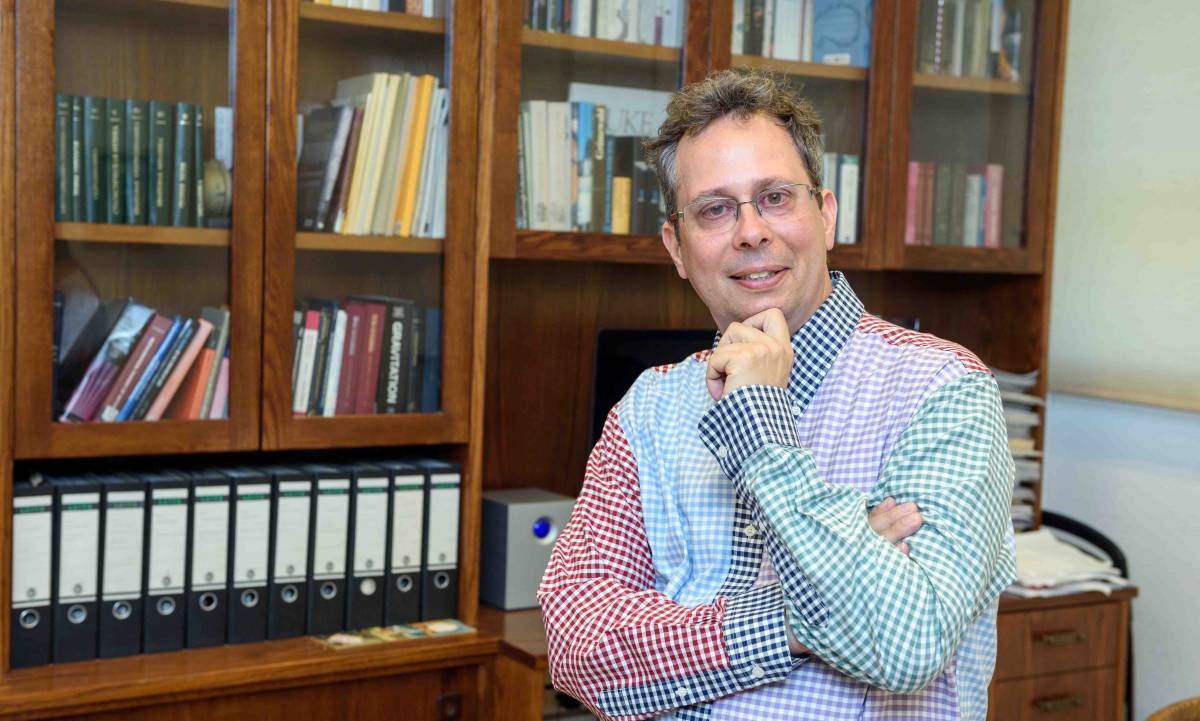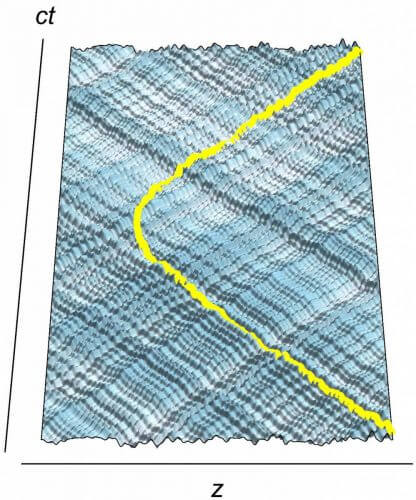Empty quantum, Prof. Leonhardt explains, is not a truly empty space. The quantum void is always buzzing with electromagnetic waves or particles that appear and disappear. "The quantum void is similar to a sea of possibilities, or alternatively to a type of credit that can be borrowed and repaid. This is what makes the noise come into being," says Prof. Olaf Leonhardt from the Weizmann Institute

Olaf Leonhardt. Brings together three fundamental fields in physics - general relativity, quantum physics and thermodynamics
If we cruise through the depths of outer space at a constant speed we will not feel like we are in motion at all. In the absolute silence of the interstellar void, we will experience only light waves emitted from the stars - and even they will appear unchanged to us, even if we cross their path. On the other hand, if we suddenly accelerate, something completely different will happen: heat radiation will flood the space around us. This phenomenon, called the "Unruh effect" after one of its discoverers, stems from the predictions of Einstein's theory of general relativity combined with quantum mechanics.
Such a journey into space is still not possible, and so far the Unro effect has not been experimentally demonstrated on Earth. Prof. Olaf Leonhardt From the Department of Physics of Complex Systems and the research group led by him, together with colleagues from France, managed to demonstrate an analog effect using a water tank, several mirrors and cameras and a number of sophisticated algorithms. Although the common perception is that the Unro effect only occurs in a "quantum vacuum", researchers now estimate that it does May also occur in everyday life.
Empty quantum, Prof. Leonhardt explains, is not a truly empty space. The quantum void is always buzzing with electromagnetic waves or particles that appear and disappear. "The quantum void is similar to a sea of possibilities, or alternatively to a type of credit that can be borrowed and repaid. This is what makes the noise come into being," says Prof. Leonhardt.
Some believe that the quantum vacuum is a medium for light waves, similar to the air through which sound waves travel. But unlike sound waves, which change when we move closer or further away from the source of the sound, light waves only change when the observer speeds up or slows down. Acceleration, therefore, is a kind of "loan" from the quantum void that creates "interest" in the form of heat. The heat creates a trail around the viewer similar to Hawking radiation that creates the event horizon of a black hole. Prof. Leonhardt explains that researchers are interested in the Unro effect because it brings together three fundamental fields in physics that usually do not overlap - general relativity, quantum physics and thermodynamics.
Experimental physicists who seek to demonstrate the effect will encounter a problem - to produce enough thermal radiation to allow the Unro effect to be measured, a vast quantum vacuum, tremendous acceleration - and an infinite amount of time are needed. And if that's not enough, the fluctuations in a quantum vacuum are sub-nanoscopic - they are defined in terms of Planck's constant, the smallest possible size, so it would be extremely difficult to measure them.

Prof. Leonhardt, his research student Itai Grineasti and Prof. Mathias Fink and his group at the Langevin Institute in Paris, were looking for an alternative system that would mimic the UNRO effect. They designed such a system in a water tank. The shaking of the container from below created standing waves on the surface of the water that have much in common with light waves, but move at a fraction of their speed. In this system, the size of the fluctuations is, of course, macroscopic - visible to the naked eye, and the acceleration required to witness a phenomenon is much smaller than that needed in the quantum version.
The research team also invented a replacement for the space traveler: the meeting of a laser beam reflected from a mirror, with the surface of the water, when moving the mirror back and forth also moves the meeting point. But they soon realized that the laser is not necessary at all: they can simulate the passenger on the computer as part of the data analysis.
A video camera recorded every ripple on the surface of the water, and the computer analysis broke down the information from a hundred cycles of the experiment into its components. "The spectral analysis we performed is similar to the analysis of light waves - or even to the analysis of sound waves designed to separate the pitch, the tone, the frequency and the decibels," says Prof. Leonhardt. "We were able to predict what the signature of the acceleration in these waves would look like - if following a certain trajectory, fluctuations beyond the fundamental waves should be thermal in nature. And these indeed correspond to the noise in the quantum space which arises from the thermal radiation of the particles".
"Then we added another twist to the plot," says Prof. Leonhardt, "second viewer". According to the theory, if two observers move in trajectories that are the mirror image of each other - slowing down while approaching each other and speeding up again while moving away from each other in perfect coordination - each of them will notice random particles or noise, but when they compare their records from the journey, it will turn out that each of them experienced the The same particles at the exact same time. Decomposing the wave recordings into their spectral components showed that the timing was indeed synchronized as the theory predicted. "Two observers - even if they are far apart - who compare their records will find that they felt identical photons or 'noise' at the exact same time."
How can one interpret the fact that random fluctuations are correlated between two observers? Prof. Leonhardt explains that what appears to be disordered in space and arbitrary in time is not so random, since, in fact, it is organized in space-time. Non-random noise, he adds, encodes information, making it a very interesting candidate for further research. "Using a very basic system, we showed that quantum fluctuations are not necessary to observe the Unro effect. This points to a deeper reality: the Unero effect may stem from classical physics and not necessarily from quantum phenomena. This can certainly be a very general phenomenon, if only we know how to look for it."

2 תגובות
Laws of Life, was there ever before the big bang in infinity there really was nothing. If there was XNUMX percent absolute nothingness, then how was the energy of the big bang created, then energy is created from something that was before it, and therefore I think that even before the big bang there was something fundamental and never before the big bang was there a state of absolute nothingness, hence there is no possibility that in the end There will be absolute nothingness and hence the nothingness before the big bang and the nothingness that exists even today in the infinity outside the limits of our universe, has nothing always been something and contrary to the logic familiar to us in practice absolute nothingness cannot exist. It is possible that God himself does not know how to explain how the fact that there is nothing is not absolute and why since time immemorial even before the big bang there has always been something basic, from where in the world has there always been something basic. It is possible that the answer to this also comes from God's great understanding and not only from the understanding of mortals like us.
Look for EPOLA